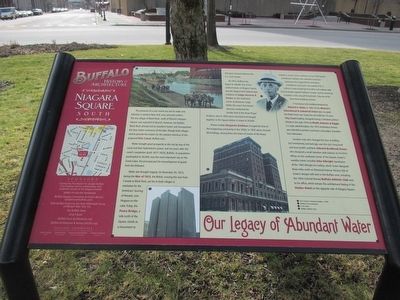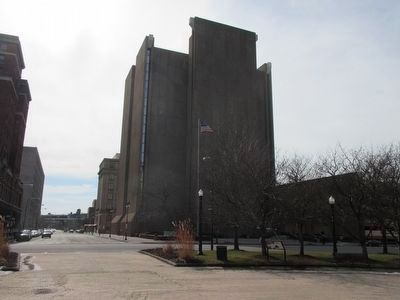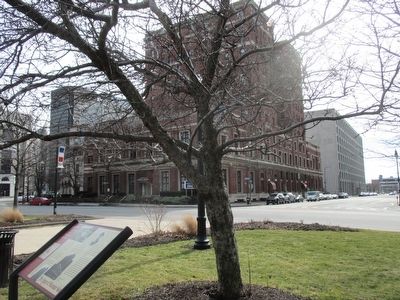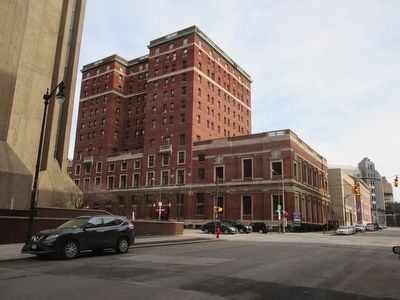Downtown in Buffalo in Erie County, New York — The American Northeast (Mid-Atlantic)
Our Legacy of Abundant Water
Buffalo History and Architecture
— Niagara Square South —
Water brought great prosperity to the city by way of the canal and later hydroelectric power. Just ten years after the canal's completeion (built 1817-1825), Buffalo, its population quadrupled to 20,000, was the most important city on the Great Lakes, the principal port for transshipment of goods from the Midwest.
Water also brougt tragedy. On December 30, 1813, during the War of 1812, the British, crossing the river from Canada to Black Rock, set fire to both villages in retaliation for American;s burning of Newark, now Niagara-on-the-Lake. Toda, the Peace Bridge, a mile north of the Square, stands as a monument to 200 years of peace between the U.S. and Canada.
By 1815, Buffalo had begun to rebuild. One of the earliest homes on Niagara Square was the elegant brick Federal style residence of Judge Herman B. Potter on the southwest corner at Delaware. Judge Potter, the area's first district attorney, conducted the murder trial of the three Thayer brothers, who in 1825 were convicted and hanged together in the Square before a crowd of 30,000.
Master builder Benjamin Rathburn changed the face of the burgeoning community in the 1830s. In 1835 alone, he built 99 buildings, among them the home of Justice of the Peace Stephen G. Austin at the southeast corner of the Square at Delaware. Rathburn also operated numerous businesses that supported his enterprise, including his own bank. The scandal on $1.5 million in notes forged by his brother and nephew with his knowledge toppled Rathburn's empire, and he wound up a resident in the very jail he had built. Only one of his downtown buildings survives.
A aandsome brick building designed by Richard A. Waite in 1892 for the Women's Educational & Industrial Union later occupied the Potter home site. Today, the site holds the 10-story City Court building. Designed during a turbulent political climate in the early 1970s by Phohl, Roberts & Biggie in a style called Brutalism, the 1974 windowless fortress was intended to protect courtrooms and judge's chambers from distraction.
Another man who changed the face of Buffalo, but handsomely and lastingly, was the city's long-lived and most prolific architect, Edward Broadhead Green, who designed a small Venetian-style palazzo as his firm's offices in the southeast corner of the Square. Green's wealthy clients included John Albright, benefactor of the 1905 Albright Art Gallery, which Green designed three miles north on Elmwood Avenue. Almost 200 of Green's designs still exist in the Buffalo area, including the 1924 Colonial Revival Buffalo Athetic Club next to his office, which echoes the architectural feeling of the Statler Hotel on the opposite side of Niagara Square.
1) Erie Canal in downtown Buffalo, c. 1908
2) Buffalo City Courthouse
3) E.B. Green
4) Buffalo Athletic Club
Erected by Community Foundation for Greater Buffalo 21st Century Fund in collaboration with Landmark Society of the Niagara Frontier, et al.
Topics and series. This historical marker is listed in these topic lists: Architecture • War of 1812 • Waterways & Vessels. In addition, it is included in the Erie Canal series list. A significant historical date for this entry is December 30, 1813.
Location. 42° 53.17′ N, 78° 52.698′ W. Marker is in Buffalo, New York, in Erie County. It is in Downtown. Marker can be reached from the intersection of Niagara Square and Delaware Avenue, in the median. Marker is at the south perimeter of the circular walkway around the McKinley Monument at the center of Niagara Square. The marker faces the monument. Touch for map. Marker is in this post office area: Buffalo NY 14202, United States of America. Touch for directions.
Other nearby markers. At least 8 other markers are within walking distance of this marker. William McKinley (within shouting distance of this marker); Niagara Square (within shouting distance of this marker); From Frontier to Major City / Buffalo City Hall (within shouting distance of this marker); "...With Liberty and Justice for All." (within shouting distance of this marker); Buffalo Burns!!! (within shouting distance of this marker); From Social Center to Civic Center (within shouting distance of this marker); Charles R. Turner (about 300 feet away, measured in a direct line); Samuel Manning Welch (about 500 feet away). Touch for a list and map of all markers in Buffalo.
Also see . . .
1. Buffalo Athletic Club - Buffalo as an Architectural Museum. (Submitted on March 3, 2016, by Anton Schwarzmueller of Wilson, New York.)
2. City Court Building - Buffalo as an Architectural Museum. (Submitted on March 3, 2016, by Anton Schwarzmueller of Wilson, New York.)
3. The Thayer Brothers - Murder by Gaslight. (Submitted on March 3, 2016, by Anton Schwarzmueller of Wilson, New York.)
Credits. This page was last revised on February 16, 2023. It was originally submitted on March 3, 2016, by Anton Schwarzmueller of Wilson, New York. This page has been viewed 394 times since then and 18 times this year. Photos: 1, 2, 3, 4. submitted on March 3, 2016, by Anton Schwarzmueller of Wilson, New York.



